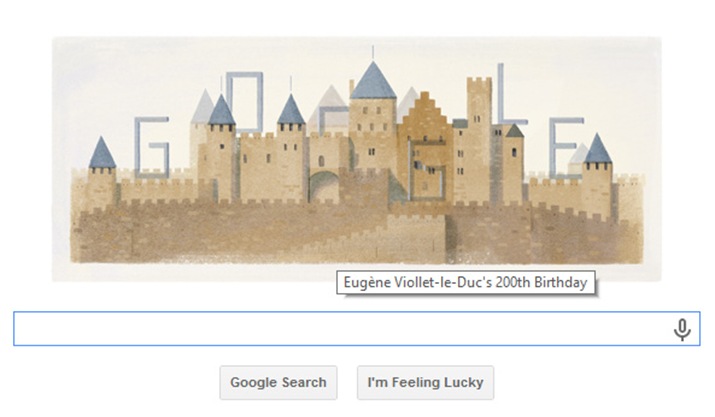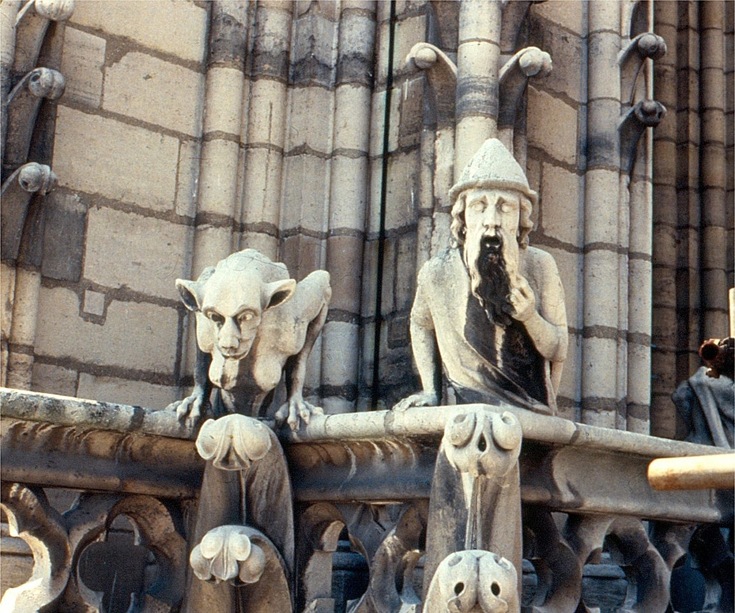Winston Smith Ministry of Truth
January 28, 2014

With today being Holocaust day, you might have thought that Google would have chosen to commemorate it on their Google doodle, but you’d be mistaken, as today Google chose instead to celebrate the bicentenary of the birth of French architect Eugène Viollet-le-Duc who is perhaps most famous—outside of France anyway—for his renovation (1845 – c.1865) of the Notre Dame de Paris (Our Lady of Paris) cathedral with its renown gargoyles and chimeras.
It was rather an unwise choice of Google’s, as it turns out that the Frenchman created one of the most famous and widely loved anti-semitic pieces of art in the world.

Of the 54 chimeras which grace the cathedral Viollet-le-Du created only one depiction of an actual human figure: the mythical “Wandering Jew,” although it’s incorrectly claimed to be “the alchemist” by neo-pagan types. The the late British professor of art Michael Camille in his study The Gargoyles of Notre-Dame states that Viollet-le-Du created a highly sympathetic portrayal of the Wandering Jew, minus his usual money-bag and scowl, and that the sympathetic view of Jew cursed to endlessly walk the Earth was popular theme during the mid-nineteenth century France, due to the highly successful novel Le Juif errant by Eugène Sue. Which, essentially, cast the Jesuits as the bad guys. According to Camile, being caught reading the novel would have had a Catholic excommunicated and its author was exiled from France.
This is another of the cathedral’s chimeras, the most famous one; the one that graces the cover of Michael Camille’s book, and another that, according to Camille, represents a Jew.

Camille devotes nine pages of his book to this chimera, in which he assiduously details each of its features and speculates on Viollet-le-Du inspiration for them: medieval works of art, contemporary studies into medieval art, and very often, mid-nineteenth century scientific disciplines such as physiognomy, phrenology, and craniology.
Camille writes of what he calls “the most famous of all Viollet-le-Duc’s creations”:
“The pensive demon’s nose would have made him appear to his contemporaries very un-French, a foreigner, if not more probably a Jew. […]
Significantly, the shape of the demon’s head is elongated horizontally rather than vertically, swerving away from the proper perpendicular of the good and the beautiful toward the dark and Semitic. […]
Faces that take this particular form can be seen in numerous anti-Semitic propaganda images produced in the first half of the nineteenth century, which show the Jew’s nose not as the audacious protrusion that would become typical of the late nineteenth- and early twentieth-century anti-Semitic stereotypes, but as an extension of the forehead, making it almost reptilian. […]
In 1850 Robert Knox linked the Jewish with the African nose: “The African character of the Jew, his muzzle-shaped mouth and face removing him from certain other races … lips very full, mouth projecting, chin small, and the whole physiognomy, when swarthy, as it often is, has an African look.” The prominent mouth of some Jews was considered by some Aryan anthropologists to be due to the presence of black blood. As for the horns, some writers of the period linked the Semitic and the satanic.”
Whilst summarising Viollet-le-Duc’s Wandering Jew and Demon Jew chimeras, Camille wrote:
“In his Lectures on Architecture where he discusses the chimeras of Notre-Dame, Viollet-le-Duc quotes the twelfth-century abbot of Cluny, Peter the Venerable, who described the civilized, enlightened and tolerant man as one for whom “there is neither Greek nor Jew; male nor female, barbarian, Scythian, bond nor free; but Christ is all and in all.” Of course, six centuries later a sense of difference was unavoidable, even for a basically tolerant and progressive mind like Viollet-le-Duc’s. What “is all and in all” is no longer a unifying and transcendent God but science, uncomprehending and unsentimental. Perhaps it is best to say that Viollet-le-Duc’s dialectical imagination created two distinct and in a sense dialectically opposed images of the cursed race, both of which have their roots in an unfulfilled but always yearning Promethean quest for knowledge. One of these—the predominantly negative image representing the inscrutable, demonic, and despised Jew—became one of the most popular sculptures on the cathedral during the next hundred and fifty years, his racial otherness repressed. The other, more idealized image of the tragic, noble, victimized, exiled, and wandering Jew has been totally forgotten.”
Michael Camille, Gargoyles of Notre-Dame: Medievalism and the Monsters of Modernity, University of Chicago Press, 2009, pp.119-132.
